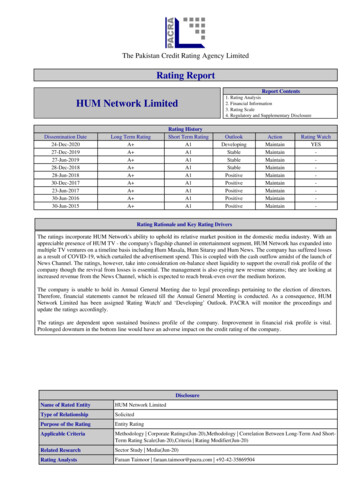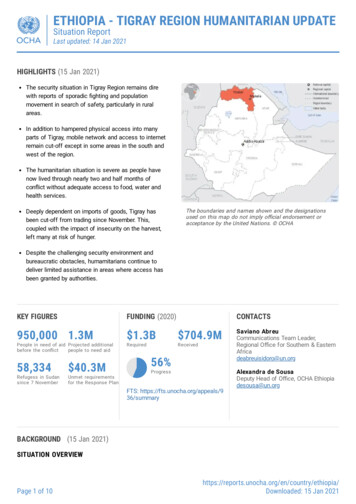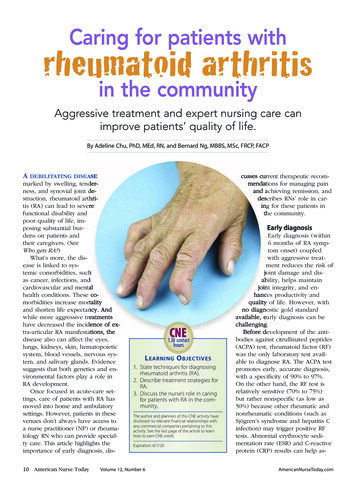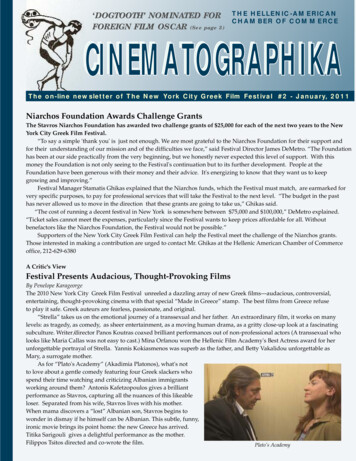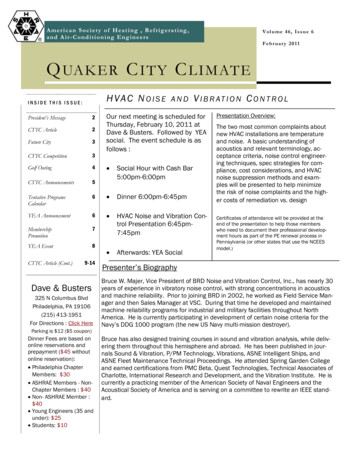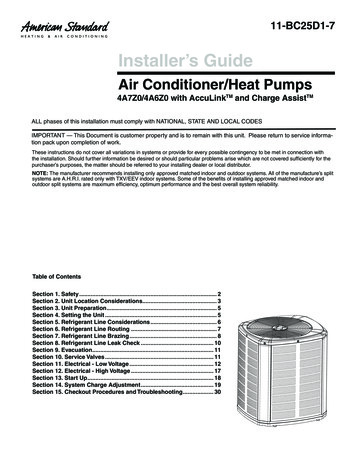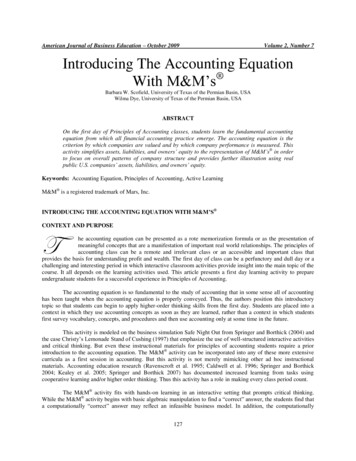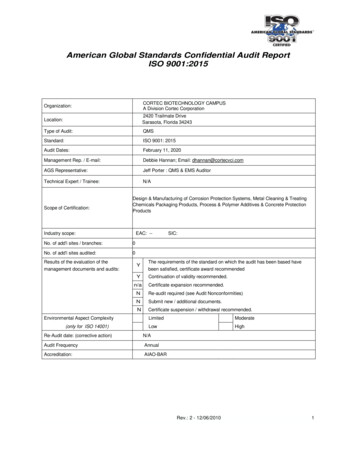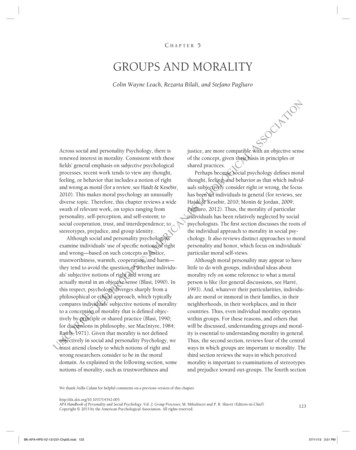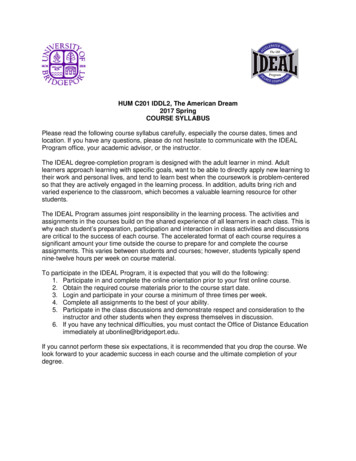
Transcription
HUM C201 IDDL2, The American Dream2017 SpringCOURSE SYLLABUSPlease read the following course syllabus carefully, especially the course dates, times andlocation. If you have any questions, please do not hesitate to communicate with the IDEALProgram office, your academic advisor, or the instructor.The IDEAL degree-completion program is designed with the adult learner in mind. Adultlearners approach learning with specific goals, want to be able to directly apply new learning totheir work and personal lives, and tend to learn best when the coursework is problem-centeredso that they are actively engaged in the learning process. In addition, adults bring rich andvaried experience to the classroom, which becomes a valuable learning resource for otherstudents.The IDEAL Program assumes joint responsibility in the learning process. The activities andassignments in the courses build on the shared experience of all learners in each class. This iswhy each student’s preparation, participation and interaction in class activities and discussionsare critical to the success of each course. The accelerated format of each course requires asignificant amount your time outside the course to prepare for and complete the courseassignments. This varies between students and courses; however, students typically spendnine-twelve hours per week on course material.To participate in the IDEAL Program, it is expected that you will do the following:1. Participate in and complete the online orientation prior to your first online course.2. Obtain the required course materials prior to the course start date.3. Login and participate in your course a minimum of three times per week.4. Complete all assignments to the best of your ability.5. Participate in the class discussions and demonstrate respect and consideration to theinstructor and other students when they express themselves in discussion.6. If you have any technical difficulties, you must contact the Office of Distance Educationimmediately at ubonline@bridgeport.edu.If you cannot perform these six expectations, it is recommended that you drop the course. Welook forward to your academic success in each course and the ultimate completion of yourdegree.
Course No. & Title: HUM C201 IDDL2, The American DreamSemester and Term: Spring 2017Day and Dates: March 6 – April 29, 2017Time: OnlineCampus Location: Distance LearningCourse Description:An interdisciplinary course which employs history, literature and philosophy to examine andexplain the cultures and values of a civilization over time and place. Works studied includeprimary historical and philosophical texts, as well as literary and artistic creations. Currently, thecourse looks at the civilization of the United States, focusing on the “American Dream,” itsorigins, growth and significance.Prerequisite Courses: ENGL 101Course Code: HUM, LAInstructor & contact information:Faculty: Joyce StashenkoEmail: jstashen@bridgeport.eduOffice Hours: Email at any time, online “live” office hours and phone conference byappointment. My cell phone number is 860.309.8999.Biography: I earned a Bachelor of Science degree in English from Central Connecticut StateUniversity in New Britain, Connecticut, and a Master of Arts degree in American Studies fromTrinity College in Hartford, Connecticut. I have also done extensive graduate level liberalstudies work at SUNY Stonybrook online, which was a revelation regarding online teaching andlearning.I taught both English and History at Granby Memorial High School for several years beforeretiring in 2013 to pursue college level teaching. While in Granby, I taught American Studies inthe UCONN ECE program (AMST 1201), as well as, UCONN US History (HIST 1501, 1502),and Advanced Placement US and Comparative Governments courses. The study of America--itsculture, its philosophy, and its politics-- has been my main interest. Writing has always been aninterest of mine and a feature of my courses.In addition to teaching Composition, Business Writing, and Humanities at The University ofBridgeport, I am teaching Composition II at Tunxis Community College in Farmington andEnglish 099 at St. Vincent’s College in Bridgeport.
Required Textbooks:Ragged Dick: Or, Street Life in New York With the Boot Blacks, Horatio Alger, SignetClassics. (ISBN#0451529839)Black Boy, Richard Wright, Harper Perennial. (ISBN#0-06-092978-2)O Pioneers! Willa Cather, Dover Thrift Edition. (ISBN#0-486-27785-2)The Great Gatsby, F. Scott Fitzgerald, Scribner Paperbacks. (ISBN#0-684-80152-3)In addition, we will read “Self Reliance”, Ralph Waldo Emerson, available in full on theInternet, and the following:The American Nightmare, from Psychology Today. Mar/Apr, 2011 by Lauren Sandler8 the-american-nightmareRethinking the American Dream by David Kamp from Vanity Fair, April ican-dream200904Downsizing the American Dream, by Marianne Cooper, The Atlantic, 15/10/american-dreams/408535/.I will also ask you to see Director Ron Howard’s 2005 film Cinderella Man, starring Russell Crowe,Renee Zellwegger, and Paul Giamati OR The Pursuit of Happyness, directed by Gabriele Muccino,starring Will Smith, Jaden Smith, Thandie Newton, and Brian Howe (2006).Many of these books are available used, at the library, or online. It doesn’t matter which publishedversion of the novels you purchase as long as you read them. .To order textbooks, go to the bookstore website at ubcampusstore.comLearning Outcomes:Upon completion of this course, the student should be able to: Understand the concept of “The American Dream”Recognize that the evaluation of The American Dream very much depends upon who isdoing the “dreaming,” what their background is, and what their expectations are.Appreciate how The American Dream has impacted every aspect of American life from art,music, literature, history and political science to sociology.Discern the contrasts between the earliest versions of The American Dream in the 19thcentury to the current 21st century views.Create a personal family narrative of The American Dream that places them at the center.Intelligently conduct online discussions via the Discussion Board in Blackboard.
Think critically and analytically and draw upon textual references in expressing theirthoughts and ideas.Appreciate the merits of primary documents, original materials from the period, in gaining apersonal understanding of events.Attain a level of comfort expressing informed opinions on issues, both verbally and inwriting.Contribute to the collaborative learning experience of the class by sharing their work andideas and working in teams.Gain additional experience in writing and researching.
First Assignment:Please be sure to have your books prior to class, as we will be pressed for time in this intenseeight-week course.For credit, write a two-page narrative on the American Dream and your place within it. Usingyour best writing skills and referring often to Samuel’s ideas specifically and also to popularculture and media, tell the story of your dream. What is it? How does it differ from the dreamsof your grandparent or from those of your contemporaries? How does your concept act as acatalyst in your life? Or is the American Dream no longer a viable aspect of American life andphilosophy? You can say anything, of course, but you must explain yourself. What do you baseyour feelings upon? What actions, realities, and happenings have caused you to feel the way youdo? Upload this first assignment by Sunday at the end of the first week of class.Assignments:Check the weekly module for particulars, but assignments are of two types, Essays andDiscussion postings.Response EssaysThere will be a three-page response paper due every other Sunday by midnight. That means youwill be writing a paper every two weeks, including the first one, which is due at the end of thefirst week of class. Your response paper should answer some question about the text, which youcan ask yourself or get from the discussion board. Your answer should be supported by quotesfrom the readings. You must reference the articles we are reading online as well as the work ofliterature we are working with. The response should be uploaded in the module where it wasassigned and should be about 750 words in length (approx. three double-spaced pages).These 4 essays are worth a combined 60% of your grade.Final Exam EssayIn addition, there will be a final exam essay in which you relate our study of the AmericanDream to ideas conveyed in a work of art, poetry or song lyrics for 20% of your grade.Discussion PostingsThe discussion boards are the “heart and soul” of an online course. Postings will be evaluatedfor effort, thoroughness, understanding of the assignment, spelling and grammar, and timelinessof posting. Late discussion postings will not be accepted. Timely online class participation isessential to this course.Each student must post at least three times a week – once (by midnight on Thursday) to explorean idea based on the week’s reading assignment and the essential questions suggested by it ( a“thread starter”) and twice (by midnight on Sunday) in detailed response to peers’ postings. It isexpected that postings will demonstrate a close reading of and a thoughtful reaction to the
assigned texts. This writing must be your own work and must not be taken from outside sources.Late work cannot be accepted, as this is a community forum -- which depends upon participationby all. Discussion board postings are worth 20% of your grade.Description of Weekly Sessions:Check the module each week for the reading, discussion board, and writing requirements. Everyweek we will read a book, essay, or see a film. Every week you will be asked to discuss thereading in discussion board and also to respond to the ideas of your peers. Every two weeks youwill write a short response paper.Grading Criteria:Reaction / Response EssayDescription: A Reaction/Response Essay is a writing assignment where you express your personalthoughts, interpretation, and evaluation of a particular topic; which could be presented through thetextbook, an article, a film, recorded music or speech, etc. It is not a research essay and investigationinto other sources is not necessary.Questions you might ask yourself: How do you feel about the topic?Do you agree with the author’s conclusion based on the presentation of facts?Could there have been another interpretation?How has this reading impacted your view of the topic?Did you realize something that was unknown to you before?Did the reading simply reinforce ideas and beliefs you already had about the topic?Did you in anyway identify with the topic?In discussing your reaction/response, it is important to make references to evidence presented. Forexample, if you disagree with the point of view of the author, please reference the specific point youdisagree with and support your claims with examples from the presentation. The intent of the essay isfor you to understand your reaction/response to the topic and express it in a logical, succinct andcompelling manner.Essay Format: APA Style: Refer to Purdue University’s OWL site for more if you need /01/Length: 2-3 Pages or 650-1,200 words.Typed using 1” Margins; Double-spaced; 12 point font.Include: Your Name; Course Name; Instructor’s Name; Title; and Date.
Introductory Paragraph: Introduce the presentation of the topic; Book or Article Title, Author, and the year it was published.Very brief summary of the topic.Thesis statement: Describe the specific issue that you are responding or reacting to; agree, disagree,connect with, evaluate etc.Organizing Ideas, Opinions, and Viewpoints: Thesis statement forms the basis of the essay.Decide on a few key ideas that express your thesis statement.Describe at least three of these key ideas.Develop your ideas in each paragraph by using examples, giving details, and using material from thepresentation.While the use of the first person “I” is generally not appropriate for academic essays, it isappropriate for a response/reaction essay since it is your personal response.Body of the Essay:Discuss the topic and your response/reaction to it referring to the presentation. If disputing the facts orthe conclusions, give solid reasons to support your interpretation.While this is not a research essay, you can certainly refer to class lectures, other readings or books.Always be accurate with the titles and authors. If you use any quotes from the text book, you may useparenthetical citation. If you quote from another book, then a footnote is necessary.Concluding Paragraph:Reiteration of your thesis statement and restatement of your response/reaction.List your sources in APA style.GRADING RUBRIC REACTION/RESPONSE ESSAYExpectationsThe introductory paragraph gives referenceto the source of the topic by indicating thetitle, author and publication date, provides abrief and concise summary of the topic andhas a specific thesis statement which reflectsthe writer's reaction and builds anexpectation in the reader.ExcellentFairPoor
Body of the essay has a well-written topicsentences and is well-supported witheffective citations and clear, mature, andoriginal ideas and refers to the originalsource whenever necessary. The concludingparagraph rephrases main points and endswith an original and meaningful concludingcomment.Organization: All ideas are relevant to eachother and to the thesis statement. Sentencesand paragraphs are logically ordered andsmoothly connected to one-another with avariety of appropriate linking devices andreference words, and/or repetition of keywords.Grammar & Mechanics: Sentence forms areaccurate. Word choice is accurate andvaried. Punctuation, capitalization, spelling,paragraphing, spacing, indentation, andmargining are proper. The ideas have beenproperly cited with a variety of citationtechniques (quotation/ summary/paraphrase). In-text and end-text referencesare complete and in the right format.
Grading Rubric for Discussion Postings(Excellent)(Good)(Fair)(Poor)Posting isinsightful,thorough, andinteresting.Posting isthorough andinteresting.Posting isinteresting butlacks insight anddepth.Posting isuninterestingand/or too brieffor theassignment.Inspires ReplyPostings fromOther StudentsA serious effort ismade to framethe discussionposting in such away as toencourage othersto reply. Postinggeneratesquestions andopens up newavenues fordiscussion.A serious effort ismade to framethe discussionposting in such away as toencourage othersto reply.Some effort ismade to framethe discussionposting in such away as toencourage othersto reply.No effort is madeto frame thediscussionposting in such away as toencourage othersto reply.DemonstratedUnderstanding ofthe ReadingAssignmentPostingdemonstrates athoroughunderstanding ofthe readingassignment and issubstantiated byseveral examplesfrom thetextbook and/orcompanionwebsite.Postingdemonstrates anunderstanding ofthe readingassignment and issubstantiated byat least oneexample from thetextbook and/orcompanionwebsite.Postingdemonstrates anunderstanding ofthe readingassignment but isnot substantiatedby examples fromthe very littleunderstanding ofthe readingassignment.Contribution to theClassroom
Grammar,Mechanics,Spelling, andSentenceStructurePosting is highlypolished; nogrammar orspelling errors.Posting ispolished;maximum of onegrammar orspelling error.Posting isadequate;maximum of twogrammar orspelling errors.Inadequateposting; morethan two spellingor grammarerrors.Course Activities and Grade WeightsDiscussion Board Participation 20%Paper Week 115%Paper Week 2 15%Paper Week 4 15%Paper Week 6 15%Final ExamTotal20%100%Letter Grading Scale:% of Points Earned Letter Grade100-94A93-90A89-87B 86-84B83-80B79-77C % of Points Earned Letter Grade76-74C73-70C69-67D 66-64D63-60DBelow 60F
ACADEMIC POLICIESAttendance PolicyCourse attendance via online participation is an integral part of the online academic experience;therefore, students are expected to be participative in all course activities and discussions. If anabsence is unavoidable, the student should communicate with the instructor. Arrangementsshould be made at that time for submission of any missed assignments.IMPORTANT: An absence (lack of participation) in any week of the course, will drop the final grade byone letter grade (for example if a student earns a grade of “B” in the course, the finalgrade would be a “C”). An absence of two or more weeks will be cause for a failing grade.Drop ProceduresTo drop a course, you must complete and submit a Schedule Change Request Form. The formcan be accessed at the IDEAL Course Schedule tes/ideal-course-schedule/.Please print and complete the form and fax the form to the IDEAL Office: 203-576-4537. Prior todropping a course, the student should contact their IDEAL Academic Advisor to understand theimplications to financial aid and/or degree plan progress.Please review the drop fees and tuition refunds at the Academic Calendar; accessed at theIDEAL Course Schedule webpage (same link above).Cell PhonesCell phones must be turned off (or placed on “vibrate”) while in the classroom. A cell phone callis disruptive and disrespectful to the other students in the class.Academic DishonestyThe IDEAL program prohibits all forms of academic dishonesty. Academic dishonesty isnormally defined as, but not limited to, the following two categories:Cheating – Using inappropriate sources of information in an assignment or on a test. Thefollowing are examples of cheating taken from real student experiences:Case #1: A student is enrolled in an introductory psychology course. He has co-workerswho have taken the same course. As the end of the course approaches, he wondershow he will find the time to get the research paper finished, and asks one of his coworkers for help. His co-worker hands him a research paper that he submitted in asimilar course. The student makes minor modifications to the paper, and submits itunder his own name.
Case #2: A student enrolled in a humanities course is unsure about how to structure anessay. She is doing research on the World Wide Web, and comes across an essaywritten by a student from another university. Using her computer mouse, she copies andpastes the essay into her word processor. She goes to great lengths to re-word thepaper in her own style, but essentially leaves the content and organization the same.Plagiarism – Intentional as well as unintentional failure to acknowledge sources as well as theuse of commercially available so-called “research papers” without full recognition of the source.Presenting as one’s own, the ideas, words, or products of another. The following are examplesof plagiarism taken from real student experiences:Case #3: A student is conducting research for a Civil War research paper. He hasreviewed work on the Internet. Finding helpful information, he has summarized hisfindings without citing his sources. He believes that minor paraphrasing is all that isnecessary.Case #4: A student is writing a paper that requires her to address specific topics andproblems in the assigned course textbook. She takes the information directly from thetextbook with slight modification, without giving any citation. She thinks that since it is thecourse textbook, she doesn’t have to use quotations or citations.Academic dishonesty applies to all courses, assignments or exams completed by students andsubmitted as their own original work, whether in person or by electronic means. The Universitydoes not tolerate cheating in any form. It is a serious breach of conduct with seriousconsequences. Instructors have the right to determine the appropriate penalty for academicdishonesty in their own courses; generally, however, such acts will result in a failing grade forthe assignment and/or the course. The penalty for subsequent acts of academic dishonesty mayinclude expulsion.More information on how to recognize plagiarism can be found at this site:http://www.indiana.edu/ istd/plagiarism test.htmlThe Use of Turnitin dot comUpon submitting an assignment via the Canvas Learning System, a student will be promptedwith the following statement:I agree and understand that this assignment will be submitted to Turnitin, a plagiarism screeningservice analyzing the extent to which this submission is original content, cited from othersources, and/or similar to existing sources in Turnitin’s database. I further agree andunderstand that this submission will be maintained in Turnitin’s database for plagiarismdetection purposes only and that I retain the copyright of this assignment. I also understand andagree that I am subject Turnitin’s Usage Policy, available at http://turnitin.com.I have read the terms and conditions of the University of Bridgeport’s (the “University”) Consentto Plagiarism Screening Policies (see below) as stated in the University Catalog and Key to UBStudent Handbook, and understand that those terms are incorporated herein by reference.Consent to Plagiarism ScreeningStudents are expected to be familiar with and to comply with the University’s policies prohibitingplagiarism as set forth above. Some courses utilize electronic screening to detect plagiarism,e.g., Turnitin. These plagiarism screening programs analyze the extent to which students’submitted assignments constitute original content and compare students’ submissions to anextensive network of web pages, articles, and other student work in their databases. Using
these resources, these programs produce originality reports which categorize submissioncontent, determining what percentage of each assignment matches text found in theirdatabases. By enrolling in course(s), students consent to the above-described plagiarismscreening programs and may also be required to approve specific terms and conditions of usewhen submitting an assignment. Students also consent to retention of their submission inTurnitin or other plagiarism screening platforms, but retain full copyright of their submission.Ethics Statement of ConfidentialityAn integral component of an IDEAL course is student and faculty expression of personalexperiences for the purpose of facilitating coursework. Students enrolled in the program areexpected to honor confidentiality as it pertains to student disclosure. Shared information,comments, or opinions expressed by another student or the faculty member during the courseof classroom discussion should never be used in a manner which is intended to humiliate,embarrass, harass, damage, or otherwise injure other students in their personal, public, orbusiness lives. In addition, confidentiality must be upheld by not disclosing any information thatwould identify any particular individual.ACADEMIC RESOURCE CENTERThe Academic Resource Center is available for IDEAL students seeking help in their studies.The Center is staffed by writing professionals and peer tutors. More information can be found at:http://www.bridgeport.edu/pages/2209.asp The Center is located on the 5th Floor of theWahlstrom Library. Make an appointment or walk-in: Telephone: 203-576-4290. OnlineTutoring is available at: www.etutoring.org. To use this free service you must have a UBNetaccount.Obtaining a UBNet AccountEvery registered student should obtain a UBNet Account. The account allows you to accessMyUB; the portal for grades, library services, Canvas online learning system. Also, the accountallows you access to computers in the Library and computer labs, and provides an emailaccount in which the University sends out information. Go to: http://www.bridgeport.edu/ubnet Click on “New UBNet Account” and follow the instructions.The @bridgeport.edu email address is the official email the University uses to send informationto you. You can have your bridgeport.edu email forwarded to any other private email accountyou use. Following the activation of your UBNet account (takes 24 hours), login at:http://www.bridgeport.edu/email and click on “forwards” at the top of the page. Follow thedirections to forward email messages to your other account.Learning Management System (LMS) - CanvasFor all courses that use Canvas, you can access Canvas through the portal by using the myUBlink. Faculty post class documents on Canvas e.g. syllabus, power points, discussionquestions, case studies, current event articles, papers, reports etc. (save some trees). Allstudents have access, and can download and copy the documents.Canvas Tutorial For Students: or assistance contact the UB Help Desk at 203-576-4606 or email ure.com/courses/829447/Accessing Your Grades & Schedule Online
The WebAdvisor online information system allows students to search for available classes,check grades, view semester class schedule and verify your personal profile. Grades aregenerally posted 2-3 weeks following the end of a course. To access WebAdvisor, login in toMyUB and follow the WebAdvisor menu on the right. If you are carrying a financial balance,access to WebAdvisor will be restricted.Using the LibraryAccess to the Digital Library is through MyUB. On the MyUB home, in the central column, clickon “myEureka Digital Library.” Research tools available: Search for books held at the library. Search the online databases for your academic field; business, counseling, humanservices, psychology, etc. Send questions to the Reference Librarian for assistance in research topics andsearching strategy.Using ComputersOpen access computer labs are available at three locations: Bridgeport – 1st floor of the Wahlstrom library. Check library hours of operation at:http://www.bridgeport.edu/library. Stamford – Room D; Check open hours at:http://www.bridgeport.edu/stamford Waterbury – Computer Lab; Check open hours at:http://www.bridgeport.edu/waterburyCourse CancellationsAny emergency necessitating the canceling of courses will be announced by the Universitythrough the Emergency Notification Telephone Line, (203) 576-4159. Please call this number forinformation on course cancellations. Also, information will be posted under “Latest News” on theUB home page, (www.bridgeport.edu). Canceled classes will be made up either the weekfollowing the end of the course or in consultation between the instructor and the students as today and time availability. Course cancellations are also announced on television and radiostations.IMPORTANT CONTACT INFORMATIONOfficeBridgeport Campus SecurityBursarCashierFinancial AidRegistrarEmergency Notification PhoneIDEAL OfficeTelephone(203) 576-4911(203) 576-4692(203) 576-4682(203) 576-4568(203) 576-4635(203) 576-4159(203) PUS CONTACT INFORMATIONCampusBridgeportStamfordAddress126 Park AvenueBridgeport, CT 066045 Riverbend DriveTelephoneEmail(203) 576-4800idealinfo@bridgeport.edu(203) 358-0700ubstamford@bridgeport.edu
WaterburyStamford, CT 0675084 Progress LaneWaterbury, CT 06705Directions to IDEAL Campus locations(203) eport.edu/pages/2260.aspTo fill out your financial aid report to the Federal Government, please go online towww.fafsa.ed.gov. The school code for the University of Bridgeport is 001416.Federal Student Aid Information: 1-800-433-3243
HUM C201 IDDL2, The American Dream . 2017 Spring . COURSE SYLLABUS . Please read the following course syllabus carefully, especially the course dates, times and location. If you have any questions, please do not hesitate to communicate with the IDEAL
